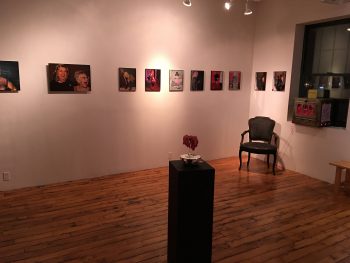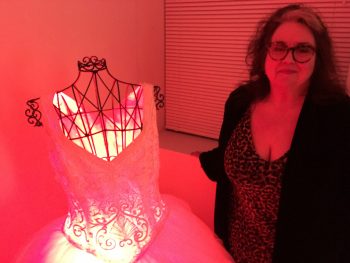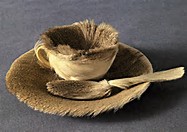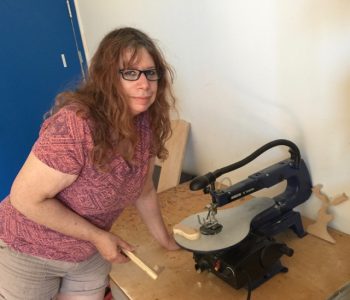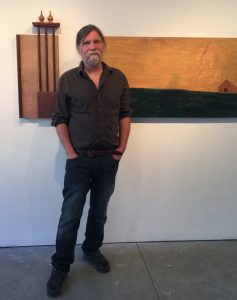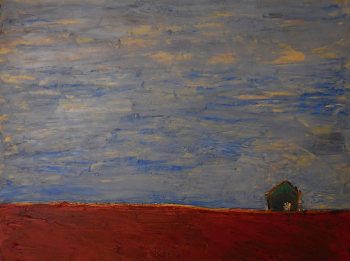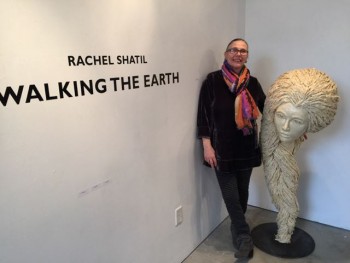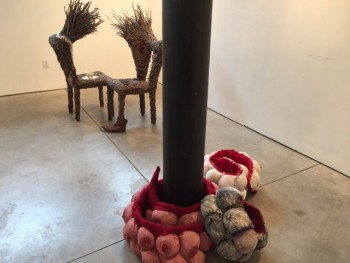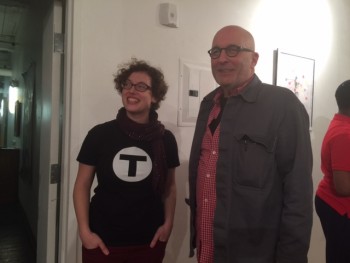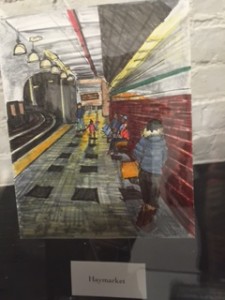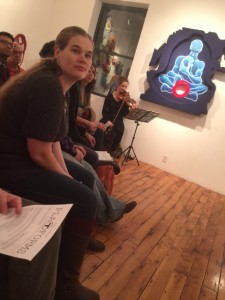
Conceptual Artist Walter Kopec and his ‘hangman’ word play drawing. At Atlantic Works Gallery, 2017.
Blue. Red. Black and White.
Not a hint of cowardly yellow bridges the Right with the Left; no grey softens the Yes and No, the Pro with the Con. There are no dips into non-objectivity. The work Walter Kopec is showing at Atlantic Work Gallery is elegant visual symbolism embedded with the tension of theoretical opposites set off against one another.
Kopec’s crisp, spare images–a pencil drawing, black tape on the wall, nail-pierced shoes, a grid of suspended red and blue ribbons–deliver complex messages; their controlled surfaces counter the irrational and compulsive inner workings of our American politics, culture and society.
The work relies on symbol and the openness of symbol interpretation. There are multiple references to the American flag. An impressive, mobile-like soft-sculpture, built from red and blue ribbons and fragments of picture frames, takes stage center. “Is the flag assembling, or disassembling?” Kopec asks. Nearby is a wall-sculpture, echoing the shape and material of the mobile sculpture but not its colors. It is a flag made of black and white stripes, which Kopec titles We Hold These Truths to Be Self-Evident “And the next part is, …that all men are created equal.” Kopec says, quoting the words of the U.S. Constitution. “And, it’s not just black-white racism that this work references,” he adds. “It’s also the black and white print medium– fact vs. fiction. Truth vs. fake news.”
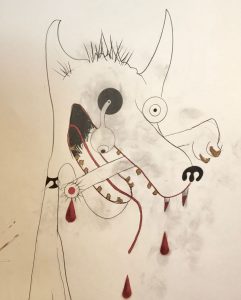
“The Last Dog Eats Alone” ( in a dog-eats-dog world) Pencil drawing with inks. Walter Kopec, 2017.
Kopec’s process is contemplative and never-ending. “I might go to my studio and read the dictionary. I might do word games, puzzles. I sit, think and write down ideas. I ask myself what’s happening in the world. What’s the drumbeat right now? ”
For 15 years Kopec’s been chronicling his ideas, words, stories. “I have boxes and boxes filled with sketches, notes, clippings, even fabric. What is this for? What can this mean? Can I use this? How? Explain it? How? For me, there’s really no start-stop in the conceptual process. My mind is always active. I even wake up at night and write notes.”
“My current conundrum,” Kopec says, “is that I grew up in the 60s and 70s. Experienced stuff that happened in the civil rights movement; during the Viet Nam War. The unfairness of it all.” Today he sees similar opposing forces fighting it out, except that now it is his generation that’s the cause of it. “The people I grew up with are responsible. What prompted this to start?” he wonders.
Two of the pieces in the show have Trump-related themes, though Kopec makes it clear he has not made
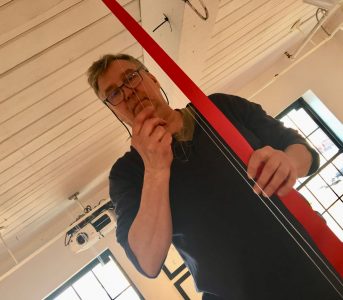
Walter Kopec in gallery installing the red stripes for …THINGS THAT REMAIN
Trump art or anti-Trump art, and that has no desire to put any of his brain power into Trump. “The art is about what is happening in society: special interests, politics for self-serving personnel gain. Trump just happened to bring it all to the forefront and pushed the ugliness in our faces.”
In the binary opposition of his show …AND THINGS THAT REMAIN, Kopec points a finger at the system we live in that considers everything either “right or wrong” , “winner or loser” ; “Democratic or Republican” ; “You’re either with us, or you’re with the terrorists.” Using cultural symbols and coded words he connects with emotions illustrating the continuing interrelated conflicts that he felt earlier in his career. “I certainly don’t have answers nor do I pretend to have answers to what’s happening,” Kopec affirms. “America is happiness. This is where people come to pursue happiness.” He points to a drawing on the wall of a stick figure running after a small American flag, which he titles Pursuit of Happiness. “ I’m not making judgement on any of this stuff. I hope the pieces appeal to a universal sense of things.”
Walter Kopec’s…AND THINGS THAT REMAIN runs in conjunction with Melissa Shook’s LANDSCAPE OF MEMORY. April 1-26, 2017. At Atlantic Works Gallery, 80 Border Street, East Boston.
“Political language, as used by politicians, does not venture into any of this territory [of the artist] since the majority of politicians, on the evidence available to us, are interested not in truth but in power and in the maintenance of that power. To maintain that power it is essential that people remain in ignorance, that they live in ignorance of the truth, even the truth of their own lives. What surrounds us therefore is a vast tapestry of lies, upon which we feed.” —Harold Pinter, upon his receiving the Nobel Prize in Literature, 2005


